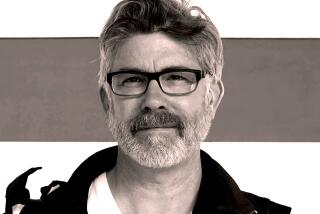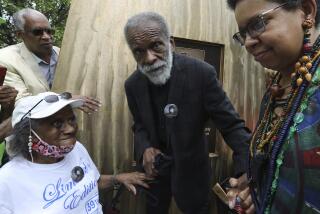Lorraine Hunt Lieberson, 52; Mezzo-Soprano of Great Range
American mezzo-soprano Lorraine Hunt Lieberson, a riveting singer known for her fearsome vocal and dramatic power, whether in opera or the cantatas of Bach, died peacefully at her home in Santa Fe, N.M., on Monday, according to Richard Gaddes, general director of the Santa Fe Opera. She was 52.
“It’s a massive loss to the opera world,” Gaddes said Tuesday. “She was one of the greatest singers of her generation. She was ... a deep, serious musician and had a great sense of theater.”
Her last professional activity was touring with the Boston Symphony Orchestra in March, singing music by her husband, composer Peter Lieberson. Before and after those dates, she had canceled many engagements, including singing in Mahler’s Third Symphony with the Los Angeles Philharmonic Sept. 29 through Oct. 1. She had performed regularly in Los Angeles in recent years.
The family had always declined to discuss questions about her health. Hunt Lieberson’s younger sister Alexis died of breast cancer in 2000, the same year the singer was diagnosed with breast cancer. She reportedly underwent surgery in 2002, then pursued treatment at a clinic in Switzerland that uses homeopathic methods as well as more conventional treatments.
Noting that she did not want her health to be an issue, composer and longtime collaborator John Harbison told the New York Times last year, “No performer wants the listener to be distracted, least of all Lorraine. Lorraine gives so much of her inner soul that that’s what she owes the public.”
Hunt Lieberson was born March 1, 1954, in San Francisco, one of four children. Her father was a music teacher who conducted local community opera productions. Her mother was a singer. Hunt Lieberson began her musical career as a violist and initially regarded voice as a secondary pursuit. Only when she neared 30 did she try for a spot in a conservatory vocal program. She failed an audition for the Juilliard School and eventually attended the Boston Conservatory.
Her big break came in 1985, at 31, when Peter Sellars cast her as Sesto in a controversial production of Handel’s “Giulio Cesare.”
“She started singing, and you were in the middle of this raging forest fire, “ Sellars recalled in a 2004 New Yorker profile of Hunt Lieberson. “Certain things were a little out of control, but what you got was sheer power, sheer concentrated energy.”
After her viola was stolen in 1988, she took it as a sign that singing was her destiny.
Hunt Lieberson regularly collaborated with Sellars. He cast her as Donna Elvira in Mozart’s “Don Giovanni” in 1987 and nine years later as Irene in Handel’s “Theodora,” an oratorio about persecuted early Christians. He also made her central to his 2001 stagings of Bach’s heart-wrenching solo Cantatas Nos. 82 (“Ich habe genug”; It is Enough) and 199 (“Mein Herze schwimmt im Blut”; My Heart is Bathed in Blood).
“People say it must be hard to do this, dredge it all up from your heart,” she said of her Bach performance in an interview with the London Sunday Telegraph last year. “But the truth is it’s fantastically liberating, because these pieces work through pain to a position of hope. They really are a journey.”
She excelled at playing larger-than-life characters -- the child-murdering mother in Marc-Antoine Charpentier’s “Medee” in Paris in 1993, the cold-hearted seductress in Georges Bizet’s “Carmen” in Boston the following year. Critics were awed by the intensity of her singing and her risk-taking as an actress.
Her deeply felt identity with the characters she portrayed on stage left her “crispy-fried in every way, emotionally, mentally and physically,” she told the Boston Globe in 2003. Even after she cut back on singing engagements for health reasons, she never lowered the voltage.
Several music experts compared her to great divas of earlier generations: Maria Callas for her total absorption in her music and Janet Baker for the strength and nobility she brought to her dramatic roles. With her long hair worn down over her shoulders and her dresses flowing to her ankles, she had an ethereal, romantic beauty that did not prepare audiences for her depths as an artist.
‘Doesn’t Fit the Mold’
She didn’t follow the star-maker formula to success but built her repertory on music that was meaningful to her. She worked repeatedly with a small group of musicians and stage directors with whom she felt a rapport, including Craig Smith, artistic director of the Emmanuel Music orchestra, and Harry Bicket and the Orchestra of the Age of Enlightenment, as well as Sellars. She was as likely to perform in small settings as on the grand stages of major opera companies or symphony orchestras. “Hunt Lieberson doesn’t fit the mold of the classical singer,” wrote Michael White in his profile of her for the Sunday Telegraph. “Her rise to international success has been selective and slow.”
Many of her admirers first heard her sing in rarely performed baroque operas. Three years after she took the lead in “Medee” in Paris and later in Brooklyn, N.Y., she captured rave reviews in “Theodora.” She sang the role during several seasons at the Glyndebourne music festival in East Sussex, England, directed by Sellars.
“Lorraine Hunt Lieberson gives a towering performance as Irene, singing with a fullness of tone and emotional abandon that sends shivers down the spine,” wrote a reviewer for the Financial Times of London in August 2003.
She was praised for bringing new insight and relevance to baroque opera. But she was also a presence on the contemporary music scene. In her debut at the Metropolitan Opera in New York City, in Harbison’s “The Great Gatsby,” she sang the role of Myrtle Wilson, the mistress of Tom Buchanan, who was married to Daisy.
“By far the strongest characterization goes to Myrtle Wilson, the floozy with whom Tom is having an affair,” wrote Opera News in March 2000. “Lorraine Hunt Lieberson made the most of this ... singing and acting in a heavily underlined torch-y style.”
‘Spellbinding’
One year after “Gatsby,” she appeared in the Paris premiere of “El Nino,” an oratorio by the contemporary composer John Adams that was later performed in San Francisco and Los Angeles.
“The simplest way to describe ‘El Nino’ is as a modern-day ‘Messiah,’ ” wrote Times music critic Mark Swed in his review of the March 2003 performance at the Dorothy Chandler Pavilion. Hunt Lieberson was one of two singers who played the role of Mary. Swed described her as “spellbinding.”
For haunting drama, nothing overshadowed her performance of the Bach cantatas in the 2001 production in New York City that was repeated in Paris and London. She appeared on stage wearing a hospital gown with medical tubes attached to her arms.
Many in the audience found the staging by Sellars melodramatic.
“Others found the performances almost unbearably moving, as much for the beauty of the singing as for the intense conviction with which she conveyed the agony of suffering and eventually the ecstasy of spiritual release,” wrote Charles Michener in his profile of Hunt Lieberson for the New Yorker.
She went on to record the Bach cantatas with the orchestra of Emmanuel Music. The CD topped a number of music critics’ “best of the year” lists in 2003.
She won even greater praise the following year for her recording of Handel arias with the Age of Enlightenment orchestra, which was nominated for a Grammy.
Hunt Lieberson returned to the Metropolitan Opera in 2003 to sing the role of Dido in Hector Berlioz’s “Les Troyens.” Although her name was not quickly associated with the Romantic repertoire, admirers maintained that her earlier performance as “Carmen” was the best they had ever seen.
She had also earned high praise as “Melisande” in a concert performance of Claude Debussy’s opera “Pelleas and Melisande,” performed with the Boston Symphony in 2003. “Her Melisande was alive to every changing emotion in Debussy’s flickeringly mysterious score,” wrote Swed in The Times.
A New Name
She was well established professionally as Lorraine Hunt when she met Peter Lieberson. He chose her for a role in his opera “Ashoka’s Dream,” about an emperor in ancient India, which was performed at Santa Fe Opera in 1997.
Hunt and Lieberson married two years later. His father, Goddard Lieberson, had been president of Columbia Records starting in the 1950s and recorded the original cast productions of such Broadway musicals as “My Fair Lady” and “West Side Story.” He also recorded works by Igor Stravinsky and other contemporary classical composers.
Lieberson’s mother, Vera Zorina, was an actress and dancer whose first husband was George Balanchine, the ballet choreographer.
“If the name was Jones, I wouldn’t have done it,” Hunt Lieberson joked about her name change.
The couple resided briefly in Nova Scotia, where Lieberson had been living, before they settled in Santa Fe because the climate was better for her health.
Soon after they married, she began to sing pieces her husband wrote for her. She performed his “Rilke Songs,” set to German poet Rainer Maria Rilke’s “Sonnets to Orpheus,” at Royce Hall in Los Angeles in 2002.
Three years later she premiered his “Neruda Songs,” with lyrics from love poems by the Chilean Pablo Neruda, at Walt Disney Concert Hall. The L.A. Philharmonic and the Boston Symphony co-commissioned the work.
In her Los Angeles performance of “Neruda Songs” in May 2005, Hunt Lieberson’s physical pain visibly affected her movements on stage.
She canceled a number of performances through that year, including engagements at New York City’s Mostly Mozart Festival in August and the world premiere of “Doctor Atomic,” a new opera by Adams at the San Francisco Opera in October.
Her frequent cancellations prompted an article about her health. After six months of rumor and concern for the beloved mezzo, she performed “Neruda Songs” in Boston with the Boston Symphony in November 2005.
“With great relief I can report that Ms. Hunt Lieberson performed on Friday looking radiant and sounding wonderful,” wrote New York Times music critic Anthony Tommasini. The audience gave her a prolonged standing ovation at the end of the evening.
However, in June of this year she canceled all scheduled appearances through the rest of the year for “professional reasons.”
‘Music of the Soul’
Throughout her career, critics often remarked on the spiritual quality of her singing.
“Music is a vehicle that can transport very high levels of energy,” she told the Boston Globe last year. “It’s something that can lift you out of a narrow little place and out of everyday existence.
“I like to listen to singers where I feel the direct openness of the heart in the voice. It’s not a veiled presentation. That’s what I want to do when I sing for people.
“They say the eyes are the windows of the soul. You could say that the voice is the music of the soul.”
In addition to her husband, she is survived by her mother, Marcia Hunt; her father, Randolph Hunt; a brother, Stan Hunt; and a sister, Susan Hunt. The memorial will be private, according to her manager, Bill Palant.
More to Read
The biggest entertainment stories
Get our big stories about Hollywood, film, television, music, arts, culture and more right in your inbox as soon as they publish.
You may occasionally receive promotional content from the Los Angeles Times.










